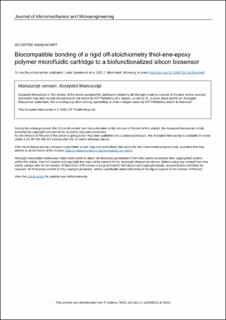| dc.contributor.author | Sønstevold, Linda | |
| dc.contributor.author | Yadav, Mukesh | |
| dc.contributor.author | Arnfinnsdottir, Nina Bjørk | |
| dc.contributor.author | Herbjørnrød, Aina Kristin | |
| dc.contributor.author | Jensen, Geir Uri | |
| dc.contributor.author | Aksnes, Astrid | |
| dc.contributor.author | Mielnik, Michal Marek | |
| dc.date.accessioned | 2022-12-05T16:03:09Z | |
| dc.date.available | 2022-12-05T16:03:09Z | |
| dc.date.created | 2022-09-26T12:28:17Z | |
| dc.date.issued | 2022 | |
| dc.identifier.citation | Journal of Micromechanics and Microengineering (JMM). 2022, 32 (7), 075008. | en_US |
| dc.identifier.issn | 0960-1317 | |
| dc.identifier.uri | https://hdl.handle.net/11250/3035936 | |
| dc.description.abstract | Attachment of biorecognition molecules prior to microfluidic packaging is advantageous for many silicon biosensor-based lab-on-a-chip (LOC) devices. This necessitates biocompatible bonding of the microfluidic cartridge, which, due to thermal or chemical incompatibility, excludes standard microfabrication bonding techniques. Here, we demonstrate a novel processing approach for a commercially available, two-step curable polymer to obtain biocompatible ultraviolet initiated (UVA)-bonding of polymer microfluidics to silicon biosensors. Biocompatibility is assessed by UVA-bonding to antibody-functionalized ring resonator sensors and performing antigen capture assays while optically monitoring the sensor response. The assessments indicate normal biological function of the antibodies after UVA-bonding with selective binding to the target antigen. The bonding strength between polymer and silicon chips (non-biofunctionalized and biofunctionalized) is determined in terms of static liquid pressure. Polymer microfluidic cartridges are stored for more than 18 weeks between cartridge molding and cartridge-to-silicon bonding. All bonded devices withstand more than 2500 mbar pressure, far exceeding the typical requirements for LOC applications, while they may also be de-bonded after use. We suggest that these characteristics arise from bonding mainly through intermolecular forces, with a large extent of hydrogen bonds. Dimensional fidelity assessed by microscopy imaging shows less than 2% shrinkage through the molding process and the water contact angle is approximately 80°. As there is generally little absorption of UVA light (365 nm) in proteins and nucleic acids, this UVA-bonding procedure should be applicable for packaging a wide variety of biosensors into lab-on-a-chip systems. | en_US |
| dc.language.iso | eng | en_US |
| dc.publisher | IOP | en_US |
| dc.rights | Attribution-NonCommercial-NoDerivatives 4.0 Internasjonal | * |
| dc.rights.uri | http://creativecommons.org/licenses/by-nc-nd/4.0/deed.no | * |
| dc.subject | Biocompatible bonding | en_US |
| dc.subject | Silicon biosensor | en_US |
| dc.subject | Silicon-polymer integration | en_US |
| dc.subject | Off-stoichiometry-thiol-ene-epoxy | en_US |
| dc.subject | Lab-on-a-chip | en_US |
| dc.subject | Microfluidic packaging | en_US |
| dc.title | Biocompatible bonding of a rigid off-stoichiometry thiol-ene-epoxy polymer microfluidic cartridge to a biofunctionalized silicon biosensor | en_US |
| dc.title.alternative | Biocompatible bonding of a rigid off-stoichiometry thiol-ene-epoxy polymer microfluidic cartridge to a biofunctionalized silicon biosensor | en_US |
| dc.type | Peer reviewed | en_US |
| dc.type | Journal article | en_US |
| dc.description.version | acceptedVersion | en_US |
| dc.source.pagenumber | 11 | en_US |
| dc.source.volume | 32 | en_US |
| dc.source.journal | Journal of Micromechanics and Microengineering (JMM) | en_US |
| dc.source.issue | 7 | en_US |
| dc.identifier.doi | 10.1088/1361-6439/ac6ebf | |
| dc.identifier.cristin | 2055421 | |
| dc.relation.project | Norges forskningsråd: 248869 | en_US |
| dc.relation.project | Norges forskningsråd: 295864 | en_US |
| dc.source.articlenumber | 075008 | en_US |
| cristin.ispublished | true | |
| cristin.fulltext | postprint | |
| cristin.qualitycode | 1 | |

